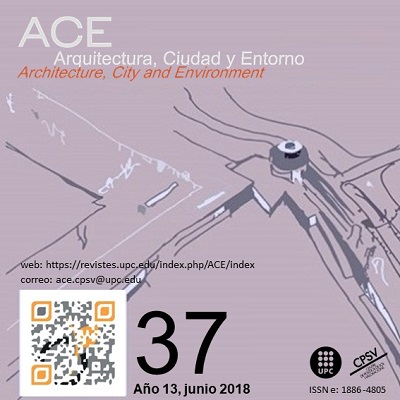Evaluation of vernacular earthern architecture in the province of Mendoza. Approaches and results
DOI:
https://doi.org/10.5821/ace.13.37.5180Keywords:
Construction techniques, adobe, rammed earth, wattle and daub, riskAbstract
Objective
The built heritage in Argentina is wide and diverse, although relatively new in chronological terms. Vernacular buildings are made by traditional means and strongly associated to the anonymous and popular culture. They comprise a large portion of that tangible and intangible heritage since it is based on the popular culture itself and on its constructive traditions. Although the built heritage in Argentina is in general at risk, is more evident in the case of the province of Mendoza, due to its environmental conditions.
This work proposes an assessment of the vernacular heritage in the north of the province of Mendoza in order to point out the keys of its deterioration, the condition of the constructive traditions and their future prospects.
Methodology
For that purpose, a sampling of the cases was carried out according to relevant situations where this type of architecture is prominent. The current situation and the perspectives are suggested by means of several surveying, evaluation and diagnostic tools.
Conclusions
Failure and risk assessment proves that the cause of the deterioration is not the assumed weakness of the traditional technique. Furthermore, the seismic risk may be low if the construction quality is adequate. It is confirmed that traditional building techniques are currently more threatened in urban areas due to their association as architecture for the poor and to the loss of traditional crafts.
Originality
The paper is set within a multidisciplinary field, where technological procedures and the key aspects involved in the decision-making policy in "heritage conservation" are identified.
Its relevance and original contribution derives from having adopted a quantitative and qualitative methodological perspective on vernacular heritage in order to understand the dynamics of the changes. Besides that, the paper shows de efficient of the informatics tools to analyze different cases in urban and rural territories.
Downloads
Published
Issue
Section
License
| INTELECTUAL PROTECTION CRITERIA |
At this moment, it is count with the "Oficina Española de Patentes y Marcas", while global protection it is being processed by the World Intelectual Property Organization (OMPI/WIPO). Nevertheless the International Standard Serial Number Office (ISSN) has given the following numbers ISSN: 1886-4805 (electronic version) and 1887-7052 (paper version). All articles will be peer reviewed, using double blind reviewing. |
| COPYRIGHT |
The article contents and their comments are authors exclusive liability, and do not reflect necessarily the journal editor commitee's opinion. All ACE published works are subject to the following licence CC BY-NC-ND 3.0 ES http://creativecommons.org/licenses/by-nc-nd/3.0/es/ It implies that authors do not hold nor retain the copyright without restrictions but only those included in the licence. |


































